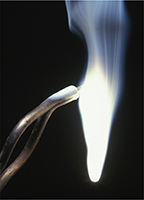Dalton's Atomic Theory
John Dalton was born in England in 1766. He was a teacher who spent his spare time doing scientific experiments. Because of his interest in predicting the weather, Dalton studied the behavior of gases in air. Based on the way gases exert pressure, Dalton correctly concluded that a gas consists of individual particles.
Evidence for Atoms
Dalton gathered evidence for the existence of atoms by measuring the masses of elements that combine when compounds form. He noticed that all compounds have something in common. No matter how large or small the sample, the ratio of the masses of the elements in the compound is always the same. In other words, compounds have a fixed composition.
For example, when magnesium burns, as shown in Figure 2, it combines with oxygen. The product of this change is a white solid called magnesium oxide. A 100-gram sample of magnesium combines with 65.8 grams of oxygen. A 10-gram sample of magnesium combines with 6.58 grams of oxygen. The ratio of the mass of magnesium to the mass of oxygen is constant in magnesium oxide.
Figure 2 Magnesium reacts with oxygen to form the compound magnesium oxide. The ratio of magnesium to oxygen, by mass, in magnesium oxide is always about 3: 2. Observing What color is magnesium oxide?

Dalton's Theory
Dalton developed a theory to explain why the elements in a compound always join in the same way.  Dalton proposed the theory that all matter is made up of individual particles called atoms, which cannot be divided. The main points of Dalton's theory are as follows.
Dalton proposed the theory that all matter is made up of individual particles called atoms, which cannot be divided. The main points of Dalton's theory are as follows.
All elements are composed of atoms.
All atoms of the same element have the same mass, and atoms of different elements have different masses.
Compounds contain atoms of more than one element.
In a particular compound, atoms of different elements always combine in the same way.
In the model of atoms based on Dalton's theory, the elements are pictured as solid spheres like those in Figure 3. Each type of atom is represented by a tiny, solid sphere with a different mass.
Recall that a theory must explain the data from many experiments. Because Dalton's atomic theory met that goal, the theory became widely accepted. Over time, scientists found that not all of Dalton's ideas about atoms were completely correct. But this did not cause later scientists to discard the atomic theory. Instead, they revised the theory to take into account new discoveries.
Figure 3 Dalton made these wooden spheres to represent the atoms of different elements.






